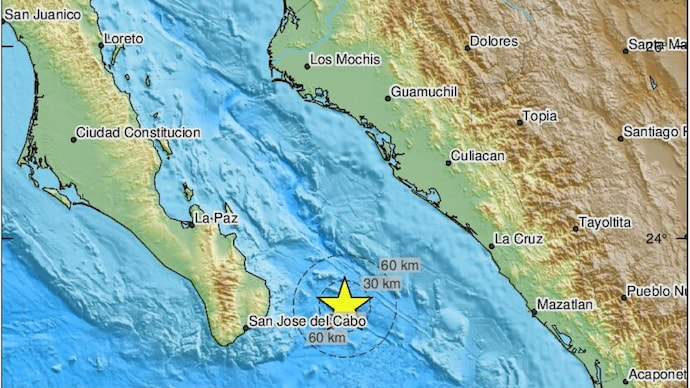Description

Disclaimer: Copyright infringement not intended.
Context: An earthquake that occurred in the Gulf of California.
Details
Earthquake Details
- Magnitude: 6.4
- Location: Gulf of California
- Depth: 10 km (6.21 miles)
- Reported by: European Mediterranean Seismological Centre (EMSC) and U.S. Geological Survey (USGS)
Impact and Damage
- Mexico's civil defense office reported no immediate damage in affected areas.Precautions advised for boats and coastal populations due to possible currents in ports.
- Small variations in sea water levels, of a few centimeters, reported in the region.
Tsunami Alert
- The U.S. Tsunami Warning system confirmed no tsunami danger for the U.S. West Coast, British Columbia, or Alaska.

About Gulf of California
- The Gulf of California is located in the northeastern part of the Pacific Ocean.
- It stretches approximately 1,126 kilometers (700 miles) from its northernmost point to the southern end.
- The gulf is bounded by the Baja California Peninsula to the west and Mexico's mainland to the east.
- It is connected to the Pacific Ocean by the narrow and shallow Strait of California.
Biodiversity and Marine Life
- The Gulf of California is renowned for its exceptional biodiversity.
- It is considered one of the most biologically diverse marine regions in the world.
- The gulf is home to numerous species of fish, mammals, and other marine organisms.
- The area's diverse habitats, including reefs, mangroves, and islands, support a rich and unique ecosystem.
Islands and Archipelagos
- The Gulf of California contains several islands and archipelagos.
- The largest island in the gulf is Isla Angel de la Guarda, while other notable islands include Tiburón Island, Isla San Marcos, and Isla Espíritu Santo.
- These islands are known for their stunning landscapes, wildlife, and recreational opportunities.
Economic Importance
- The Gulf of California plays a significant role in the economy of the region.
- Fishing is a major industry, with the gulf supporting important fisheries for species like shrimp, sardines, and tuna.
- Tourism also contributes to the local economy, with visitors attracted to the region's natural beauty, wildlife, and water sports.
Environmental Concerns
- The Gulf of California faces environmental challenges, including overfishing, habitat degradation, and pollution.
- Conservation efforts are underway to protect the region's marine resources and preserve its biodiversity.
- The gulf is designated as a UNESCO World Heritage site to recognize its ecological importance and promote conservation.
Scientific and Research Significance
- The Gulf of California has attracted scientific interest due to its unique geological features and diverse ecosystems.
- Researchers study the gulf to understand tectonic processes, marine ecology, and evolutionary biology.
- It serves as a natural laboratory for various scientific investigations.
|
PRACTICE QUESTION
Q) Which of the following statements about the Gulf of California is correct?
A) The Gulf of California is an inland sea connected to the Pacific Ocean.
B) The Gulf of California is located on the east coast of Mexico.
C) The Gulf of California is known for its rich biodiversity and is home to numerous marine species.
D) The Gulf of California is formed by the collision of the Pacific and North American tectonic plates.
Answer: C
|
https://www.indiatoday.in/india/story/earthquake-of-magnitude-64-jolts-gulf-of-california-no-damage-reported-2394715-2023-06-19















